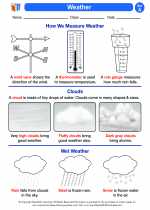Microorganisms
Microorganisms, also known as microbes, are tiny living organisms that are invisible to the naked eye. They are found everywhere - in the air, water, soil, and even inside our bodies. Microorganisms play a crucial role in the environment, medicine, and industry.
Types of Microorganisms
There are five main types of microorganisms:
- Bacteria: Single-celled organisms that can be found in various shapes and sizes. Some bacteria are harmful, causing diseases, while others are beneficial and help in processes like digestion and nutrient recycling.
- Viruses: Viruses are not considered living organisms as they cannot survive or replicate without a host cell. They are responsible for causing various diseases in humans, animals, and plants.
- Fungi: Fungi include yeasts, molds, and mushrooms. They play a vital role in decomposition, food production, and the creation of antibiotics.
- Protozoa: Single-celled organisms that are found in water and soil. Some protozoa are parasitic and can cause diseases like malaria and dysentery.
- Algae: Algae are primarily found in aquatic environments and are responsible for producing a significant portion of the world's oxygen through photosynthesis.
Importance of Microorganisms
Microorganisms have a significant impact on our lives and the environment:
- They play a crucial role in nutrient recycling and decomposition.
- Microorganisms are used in various industrial processes, such as brewing, baking, and the production of antibiotics and vitamins.
- They are essential for the treatment of wastewater and the bioremediation of contaminated environments.
- In medicine, microorganisms are used to produce vaccines, insulin, and other pharmaceutical products.
- Microorganisms also play a key role in the maintenance of our immune system and overall health.
Study Guide
To understand microorganisms better, consider the following study guide:
- Learn about the characteristics and classification of bacteria, viruses, fungi, protozoa, and algae.
- Explore the roles of microorganisms in the environment, industry, and medicine.
- Understand the importance of microorganisms in processes such as nutrient recycling, decomposition, and bioremediation.
- Study the various industrial applications of microorganisms, including food production, pharmaceuticals, and wastewater treatment.
- Explore the impact of microorganisms on human health and immune system function.
By studying microorganisms, you'll gain a better appreciation for the vital role they play in sustaining life on Earth and their diverse applications in various fields.
[Microorganism] Related Worksheets and Study Guides:
.◂Science Worksheets and Study Guides First Grade. Weather
Study Guide Weather
Weather  Activity Lesson
Activity Lesson Weather
Weather  Worksheet/Answer key
Worksheet/Answer key Weather
Weather  Worksheet/Answer key
Worksheet/Answer key Weather
Weather  Worksheet/Answer key
Worksheet/Answer key Weather
Weather  Worksheet/Answer key
Worksheet/Answer key Weather
Weather  Vocabulary/Answer key
Vocabulary/Answer key Weather
Weather  Vocabulary/Answer key
Vocabulary/Answer key Weather
Weather 

 Activity Lesson
Activity Lesson
 Worksheet/Answer key
Worksheet/Answer key
 Worksheet/Answer key
Worksheet/Answer key
 Worksheet/Answer key
Worksheet/Answer key
 Worksheet/Answer key
Worksheet/Answer key
 Vocabulary/Answer key
Vocabulary/Answer key
 Vocabulary/Answer key
Vocabulary/Answer key

The resources above cover the following skills:
Earth Systems Science
Earth's materials can be compared and classified based on their properties. Students can:
Identify and represent similarities and differences such as the texture, size, color, and shape of various materials on Earth